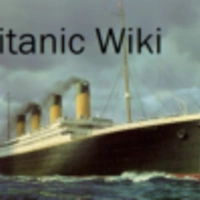
The Isolation ward on the Queen Mary. Titanic's hospital might've look something like this
The hospital of the Titanic was located on D Deck, at the starboard side close to the Second Class Dining Room and next to the galleys. It could be accessed through the surgery room on C Deck, which had a staircase to the hospital below. The hospital on D Deck was used by the 1st and 2nd class passengers.
Operated by Dr. O'Loughlin and Dr. Simpson, the hospital was equipped with a large assortment of medical instruments and medicines, which included Creosote used for severe vomiting and for toothaches, Spirit of Chloroform used to relieve stomach pain and flatulence and Lead and Opium Pills useful for diarrhoea and stomach and bowel bleeding, contain one grain of opium.
The poor and unhealthy were kept apart from the affluent in first class. Medical facilities aboard ship further told a story of class separation. According to the British Board of Trade regulations, in effect when Titanic was built, both steerage passengers and crew were to have separate hospitals, of not less than eighteen square feet for every fifty steerage passengers (Great Britain).
The hospitals were to be as far away from the living quarters, as possible, well ventilated and well lighted. They were to have beds, bedding and utensils, and be maintained throughout the voyage, under the supervision of the emigration officer, who is also responsible for the isolation portion of the hospital. Although it appears that no records or photographs of the medical facilities on board Titanic are known to exist, we do know that there were hospitals aboard ship.
From studying the plans of both the Titanic and her sister ship Olympic, we can see the ship's hospitals. There was a hospital on D Deck, with twelve beds and an infectious ward of six beds in two rooms. This infectious ward was important because it contained disease that could easily spread on a ship. No records exist to know whether this ward was actually used.
There were also four beds in the crew hospital under the after part of the forecastle at the bow on C Deck, where the crew's quarters were located.
Both of these hospitals had a surgery or a place where the ship's surgeon could treat patients. A treatment room was also available on the aft or rear side of the #6 hatch on D deck. On C deck, there was a surgery and the surgeon and assistant surgeon's quarters. The physicians, both the Surgeon and Assistant Surgeon, did have small quarters. They each had a small room, on C deck, near the surgery.
The Engineering crew had a surgery room of their own, was located on C Deck under the Forecastle Deck in the bow of the ship. The 3rd class had a dispensary further aft on D Deck.
Required Medicines on board
- Spirits of Ammonia — a stimulant, for stomach pain, headache and faintness.
- Bicarbonate of Soda — for indigestion and heartburn
- Black Drau — ht (Mistura Seance Composite) for constipation
- Bromide of Potassium (Potassii Broniidum) — a mild sleeping pill and tranquilizer
- Camphor (Camphora) — In small doses to relieve gas accumulated in the stomach or intestines.
- Castor Oil (Oleuni Riciiii) — for constipation and diarrhea, caused by some irritant such as fruit or bad meat.
- Compound Tincture of Chloroform and Morphine (Tincura Chloroformi et Morphinece Composite) — useful as a sedative in cases of neuralgic headache, fever, coughs and restlessness. Also recommended for colic, diarrhea and dysentery
- Creosote — used for severe vomiting and for toothaches
- Elixir of Vitriol (Acidum Sulphuricum Arontaticum) — For diarrhea
- Epsom Salts (Magnesce Sulhas) — a purgative for constipation
- Tincture digitalis — heart medication
- Blue Pill (Pilula Hydrargyri) — useful in bilious attacks (probably gallbladder attacks)
- Cough Pill (ipecacuanha, squill & ammoniacum) — for dry coughs and neglected colds
- Lead and Opium Pill (Pilula Plumbi cum Opio) — useful for diarrhea and stomach and bowel bleeding. Contains one grain of opium
- Dover's Powder (Pulvis Ipecacuanhae Compositus) — used for pain, restlessness, dysentery and diarrhea.
- Salicylate of Soda (Sodii Salicylas) — for high fevers and rheumatic fever
- Aspirin (Acetylsalicylic acid) —for high fevers and rheumatic fever
- Spirit of Chloroform (Spiritus Chloroformii) — used to relieve stomach pain and flatulence.
- Sulphur (sublimed) — for piles (hemorrhoids)
- Sweet Spirits of Nitre (Spiritus Aetheris Nitrosi) — used for palpitations, flatulence, cold with fever, kidney medication, and in cases of dropsy (an excessive accumulation of fluid in a body cavity or in the tissue).
- Landanum (Tinctura Opii) — used as a pain reliever and sleeping medication, containing I gram opium
- Nitre or Saltpetre (Potassii Nitras) — to reduce fever and increases urination.
- Landanum (Tincture Opii) — used as a pain reliever and sleeping medication, containing I gram opium
- Nitre or Saltpetre (Potassii Nitras) — to reduce fever and increase urination
- Paregoric (Tincura Camphorae Coniposita) — used to treat coughs, colds, chronic bronchitis and consumption; contains one-fourth grain of opium
Wreck
Due to it's location on the starboard side, the hospital was exposed to the ocean when the stern hit the seabed after the shell plating tore itself off the ship. It was destroyed on the way down
